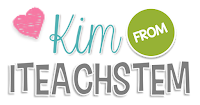I can't believe it's finally here!
February 10th.
{happy dance}
Why is that?
Well, back in early January I was asked to join The Elementary Entourage as one of their monthly bloggers. (Thanks to my friend, Brittany, from Tickled Pink in Primary for thinking of me!) I've been following this blog and am constantly amazed at the wonderful and inspiring ideas that are shared every day. I've been itching to share some of my ideas ever since I found out my day to blog would be the 10th of each month.
I've been blogging over at iTeachSTEM (Feel free to follow me there as well!)
But nothing compares to being part of a collaborative group. You know the saying, two minds are better than one? Well in the case of The Elementary Entourage, 23 bloggers are better than one! Plus, how much cooler can you get than to be a part of such an amazing group of teacher bloggers?!? (not much, trust me) I'm super pumped to get to share some of MY ideas with you lovely blog readers starting today!
So, without further ado...
Here's my FIRST official post.
{squeals with excitement}
When I first started thinking about a read aloud book to share, I was stumped. I mean, I teach 5th grade STEM. When would I do a read aloud? It's not like I teach reading anymore. In fact, I just sold about 2/3 of my old classroom library on BooKoo! When I used to teach all subjects I had a favorite book - Touching Spirit Bear by Ben Mikaelsen if you wanna check it out. But I seriously had to wrack my brain to think of a book I actually use and love reading to my class currently.
Anyhoo...
I digress.
Did I mention I tend to get off track someti ...
Focus, Kim, focus.
{deep breath}
The book I decided to share as my favorite read aloud is written by Eric Carle.
Haven't heard of him?
He's the author of The Very Hungry Caterpillar and Brown Bear, Brown Bear, What Do You See? (plus like 70 other awesome books).
I've used his picture book Pancakes, Pancakes! every year during my unit on physical and chemical changes in matter. And the students LOVE it! Even "big kids" like having a story read aloud to them once in a while - go figure!
Here's kind of how I do things in my class:
Students create a chart to record any examples of physical changes or chemical changes that they see or hear in the book. I usually have them just make a simple T-chart in their interactive notebooks, but I have also given them this handout to glue into their notebooks. It all depends on how close I am to my copy count limit, honestly.
I put the book on the document camera so kids can see the pictures (and so I can walk around the room while I am reading). Then I begin reading. When I come to the first example - using the sickle to cut the wheat - I stop and tell students that I just noticed an example of a change in matter. {hands shoot up} I ignore the hands and continue my think-aloud to model what I want them to do. I say something like, "Cutting the wheat changes it's SHAPE, so I know that is an example of a physical change in matter." Then I get my class interactive notebook and write "cutting wheat" under the heading of physical changes.
For the next couple pages, I use the tone of my voice to stress each example and pause dramatically {Yeah, you're surprised I have drama in my class, right?} until I know they have caught on to what I am looking for. After most of the students get the hang of listening and looking for examples in the story, I start moving a bit quicker.
After I am finished, I give students about 2 minutes to compare their notes with a partner or with their table groups. I let them add to or change their lists as they discuss their ideas.
Finally, I allow students to come up (alternating groups) to write down an example on the class chart - being careful not to duplicate an entry. If a student or group places an example in the wrong category, we discuss why it fits better in the other one. I clarify any misconceptions (usually about the grain being ground into flour and the cream being churned into butter). And while students are sharing with the class, I make pancakes for them to snack on. Yeah, I'm THAT awesome of a teacher!
Wait!
Before you go getting all jealous of how AMAZE-BALLS I am, let me admit something.
I really just heat up those little packets of mini pancakes in the microwave.
But I DO ask kids if heating them up is a physical or chemical change.
(Hint: It's a physical change.)
I also have a little story I send home with them as a homework assignment. It's called "The Adventures of Mrs. Coker". In it, they must identify the physical and chemical changes that happen to me throughout my day. They, of course, get a kick out of it. Many times they are dying to know if the story is true or not. They even make predictions. Sad that they assume burning waffles is TRUE, but they know me so well.
If you want to try this activity in your class, just snag a copy of the book and download a FREE copy of my Pancakes, Pancakes! chart by clicking HERE. And best of all, the book is probably in your school library already! Check with your super awesome and incredibly helpful librarian. And if for some reason that doesn't work, you can buy it here on Amazon (my favorite supplier of ALL THINGS - seriously).
Hey!
By the way...
This month we are giving away a pair of those AWESOME Tieks that everybody loves so much! I don't know about you, but I hear they are "heavenly" to wear - especially for those of us on our poor feet all day...
Enter by using the rafflecopter link below. Good luck!
a Rafflecopter giveaway
Thank you SOOOOOOO much for reading my blog post.
Leave a comment if you will so I know you enjoyed it.
And sorry for the cheesiness.
It's a gift (and a curse).
Until next month...











Would it be possible to see or get a copy of The Adventures of Mrs. Coker?
ReplyDeleteWould love a copy of your homework.
ReplyDelete